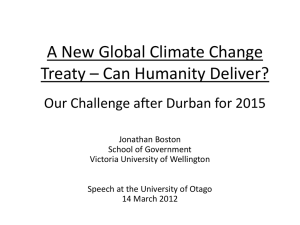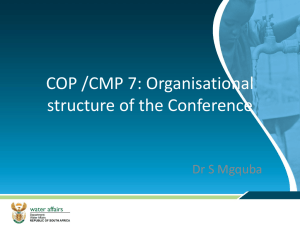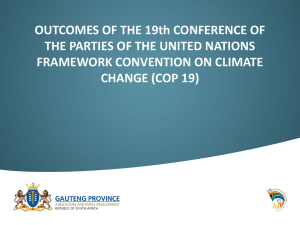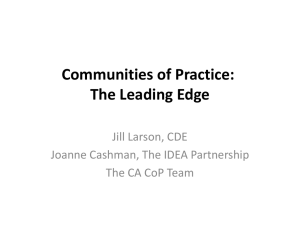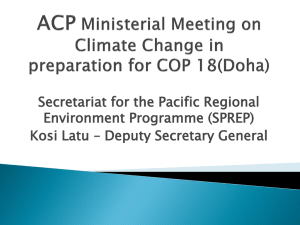The United Nations Framework Convention on Climate
advertisement
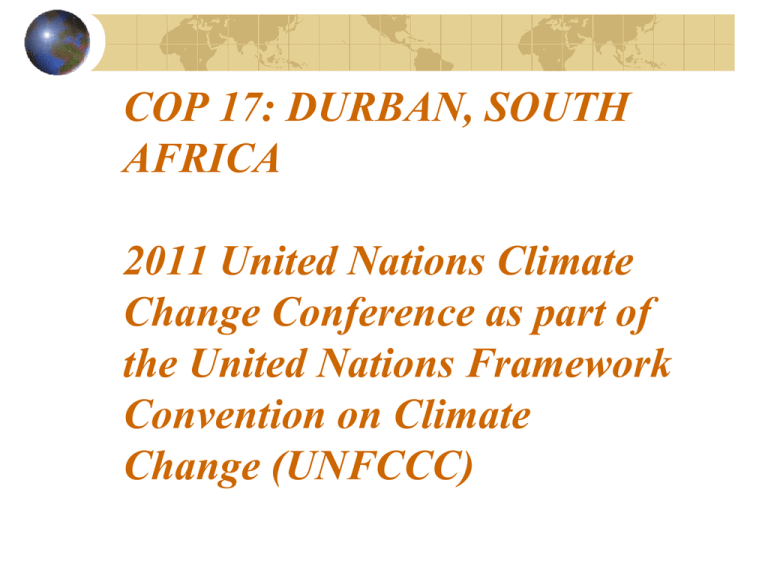
COP 17: DURBAN, SOUTH AFRICA 2011 United Nations Climate Change Conference as part of the United Nations Framework Convention on Climate Change (UNFCCC) Overview Background High-Level Outcomes Canadian Positions Next Steps 1. Background The timeline 1992: countries joined an international treaty, the United Nations Framework Convention on Climate Change, to cooperatively consider what they could do to limit average global temperature increases and the resulting climate change, and to cope with whatever impacts were, by then, inevitable 1995: countries realized that emission reductions provisions in the Convention were inadequate. They launched negotiations to strengthen the global response to climate change, and, two years later, adopted the Kyoto Protocol 2012: what happens from here is one of the key issues governments from the 195 parties to the Convention are currently negotiating The process Parties refers to the States that have signed on to the UN Framework Convention on Climate Change (UNFCCC) The Parties have been meeting annually in Conferences of the Parties (COP) to assess progress in dealing with climate change since 1995 COP 17, the 17th Conference, met last year UNFCCC Set an overall framework for global efforts to tackle the challenge posed by climate change Governments are required to: (i) gather and share information on greenhouse gas (ii) launch national strategies to address it (iii) cooperate in preparing for adaptation to the impacts of climate change The Kyoto Protocol Sets binding targets for 37 countries for reducing greenhouse gas emissions (GHG) Reductions amounting to an average of 5% over the five-year period 2008-2012 is expected Kyoto v UNFCCC: UNFCCC encourages countries to stabilize GHG, the Protocol commits them to do so Schematic 156 Countries (China, India, not U.S.) COP/MOP 35 Countries Kyoto Protocol (entered into force 2005) Annex b (targets) 187 countries (includes U.S.) Framework Convention on Climate Change (entered into force 1994) Annex 1 Post 2012: Toward further commitments International Negotiations New Treaty Agreed to Formal Mandate Dialogue Phase COP 12 2006 SB Formal Negotiations Phase Detailed Rules COP 13 COP 14 COP 15 COP 16 2007 Bali 2008 Poland 2009 Denmark 2010 Mexico 1st Kyoto Compliance Period COP 17 2011 Durban COP 18 COP 19 2012 Qata r 2013 2nd Kyoto Period “Mind the Gap” IPCC 4th AR Non-UN The Cancun Agreements COP 16 was held in Cancún, Mexico in 2010 and agreed a set of significant decisions: (i) to address the long-term challenge of climate change collectively and comprehensively over time and to speed up the global response. (ii) key steps forward in capturing plans to reduce greenhouse gas emissions and to help developing nations protect themselves from climate impacts Durban Durban, COP 17 COP 17 took place Nov 28-Dec 9 2011 in Durban, South Africa Alberta part of the Canadian delegation – all rights and privileges (Guy St. Jacques, Chief Negotiator and Ambassador for Climate Change) Alberta visibility at such an international meeting carries significant weight in international circles Alberta at COP 17 Targeted meetings with: Delegations from China, UK, Norway, France, Japan, Indonesia, Germany Interest groups- ENGOs Academia-particularly those with an interest in Canada & environmental issues Business leaders in energy-intensive sectors Media, opinion-leaders (global media hub) COP Process “Conference-like” Side Events (open to all) Cdn. Delegation Daily Briefs Closed Door Negotiations 2. High Level Outcomes Outcomes of COP17 The “Durban Platform” (i) to negotiate the long-term future of the regime (ii) a second commitment period for the Kyoto Protocol (iii) and an array of decisions designed to implement the Cancun agreements Assessing the Durban Platform Opinion is divided Overall it holds a great deal of merit Establishing the future direction of the climate regime by initiating a new round of negotiations to be concluded by 2015 and operationalized by 2020. The text that ultimately brings all Parties onto one track and tries to resolve the difficult conflict between equity and environmental integrity Assessing the Durban Platform contd. The text calls for “the widest possible cooperation by all countries and their participation in an effective and appropriate international response” It also recognizes the need to strengthen the multilateral, rules-based regime Importantly, the text notes and expresses concern at the significant emissions gap and reconfirms the long-term global goal of limiting warming to 2°C The tacit criticism of existing pledges seems to suggest that the voluntary “pledge and review” system is now time-bound The Second Commitment Period of the Kyoto Protocol The agreement in Durban extended the Kyoto Protocol, providing a transition period for the parties The second commitment period under Kyoto is set to begin on January 1, 2013 and end either on December 31, 2017 or December 31, 2020 Parties who sign up to the Second Commitment Period are committing to reduce emissions by at least 25%-40% below 1990 levels by 2020. Climate Finance Durban grappled with a number of important issues related financial resources, including: (i) launch of the Green Climate Fund (GCF) (ii) provision of long term finance (iii) the Standing Committee, and transparency of finance. The launch of the GCF was one the most important outcomes from Durban Transparency and Reporting (MRV) COP 17 set out to deliver detailed rules to account for, report, and review countries’ GHG emissions, actions, and finance Cancun sketched out the main parameters of this system Although COP 17 made the MRV system operational it fell short on several important items that would have ensured the environmental integrity of the regime Adaptation COP 17 saw renewed momentum on adaptationrelated decisions supporting implementation of the Cancun Adaptation Framework: (i) a new Adaptation Committee to coordinate (ii) a process to enable least developed countries to formulate and implement national adaptation plans (iii) a new Work Program on Loss and Damage (iv) renew the existing Nairobi Work Program on various adaptation issues Technology: CCS Kyoto Protocol Article 2.1 (a)(iv): Recognizes “Carbon dioxide sequestration technologies” as a mitigation technology that promotes sustainable development COP6: Annex I &II Parties cooperate in the development, diffusion and transfer of CCS, encourage their wider use and facilitate the participation of LDCs and other nonAnnex I Parties CCS must be rapidly deployed in developing countries Limited funding for CCS to date:<0.001% climate finance to CCS International effort primarily on inclusion of CCS in CDM Importance of CCS in the CDM Legitimizes CCS as a valid technology for developing countries CCS also requires support from other mechanisms (i.e.NAMAs) Creates incentives/signal for CCS in developing countries Stimulates development of national regulations and capacity Could support low cost CCS opportunities Part of the solution for power and higher cost industrial applications Establishes precedent-setting regulatory framework for CCS can be utilized under other international funding mechanisms 3. Canadian Positions Levels of Climate Change Policy UN Climate Change Treaties Top Down Pressure Canada’s International Positions Canada's National Climate Policy Response Bottom Up Response AB/Federal Discussions Ex: Coal, Oil & Gas Alberta’s Climate Change Policy Response ***Canada’s position*** Canada maintained the position set out at Copenhagen: (i) moving away from the Kyoto framework to a longterm comprehensive agreement involving commitments by all major economies (ii) A national target reflecting Canada’s diversity and unique circumstances – currently a 17% reduction from 2005 levels by 2020 (iii) To reflect a pragmatic balance of economic and environmental interests (iv) Support the development and deployment of clean energy technology Canada’s 6 Key Elements of a New Climate Regime 1.Post 2012 to be environmentally effective by pursuing the deep and broad global emission reductions 2.Broadening participation through sectorbased strategies 3.Advancing development goals in a sustainable manner Canada’s 6 Key Elements of a New Climate Regime cont. 4. Building a strong global market by grounding the approach in sound economic principles 5. Realizing the full potential of technology by better integration of mechanisms and incentives 6. Tackling adaptation as an integral part of the new global system 3. Alberta’s Position Alberta Principles The principles guiding Alberta’s contribution to the international discussions: 1. Comprehensive 2. Energy-Economy-Environment Balance 3. Equitable 4. No inter-regional wealth transfer 5. Technology-focused 6. Emphasis on reduction at source Alberta Objectives Work towards an agreement that meets the nation’s diverse needs and interests Enhance Alberta’s awareness of the range of global national and subnational efforts to address climate change Share Alberta’s climate change learnings and experience on a world stage COP 17 Strategic Policy Priorities Continue with Kyoto – or develop something new? * Alberta View: open to idea that it is time to try something new Big emitters: Inclusion of China/India/U.S. in the next treaty * Alberta View: strongly support this – a must Advance technology options instead of targets etc * Alberta View: focus more attention on the real impacts of climate change that are happening in Canada now . COP 17 Strategic Policy Priorities contd Deep (50%) reduction targets: by 2050 as per the IPCC advice * Alberta View: support, but national circumstances need to be recognized Carbon markets – continuation of the Kyoto market mechanisms * Alberta View: carbon markets have a role to play Technology: much more emphasis needed * Alberta View: strongly support this – a must Criteria for a New Climate Regime beyond 2012: AB Advice National Sustainability – supports National provincial/territorial sustainability efforts and circumstances; Global Sustainability – a new climate change framework should make a real difference to global sustainability Realistic Engagement – the US and all developed and developing countries with large GHG emissions must be part of the next regime 4. Next steps Future meetings MEF in Los Cabos, Mexico G8 Leaders Summit Bonn, Germany intersessional COP18 Doha, Qatar Dec 2012 Conclusion What does this mean for Canada? What does this mean for policymakers? What can Canada do to remain an influential voice in light of Kyoto withdrawal? Has Canada lost legitimacy among the international community? Questions? zeeshan.syed@gov.ab.ca

